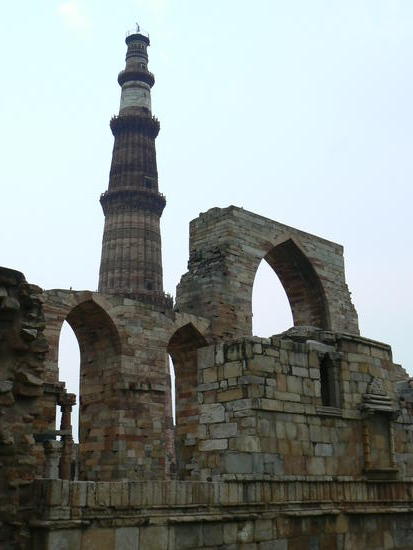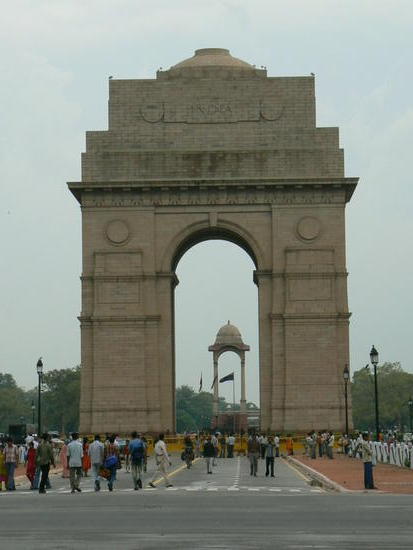Delhi takes turns at being fascinating and infuriating.
With a couple of days before I join a tour group, I endeavour to see the sights of Delhi not on the itinerary, in particular, the remains of the Mughal complex of Qutb Minar, 10k south of Paharganj where I’m roosting. There is a local bus that goes there but at New Delhi Station ‘helpful’ touts recommend I stick with the safer, more comfortable, more direct, tourist bus, and they point me in the direction of Connaught Place. I insist on walking against their preference. This leaves me at the mercy of further ‘helpful’ guides. An English student leads me not to the bus stop but to a tourist agency. He also suggests I start dressing like an Indian to avoid paying tourist rates.
I am amused to spend my first morning in Delhi letting the city have its way with me, being led by people I believe are genuinely out to help me. I don’t catch the bus in the end but succumb to the first offer of a cup of tea and strike a deal to hire a car for the day. Sanjeev at Nexus Tours (slogan: We elecit the world clase) is surprised that I am staying in Paharganj as I do not strike him as either a hippy or a druggist.
Booking the car is more economical for seeing far-out Qutb Minar, but also a loop of other distant sights. My driver, Kemal, has modest English but gets me through the chaotic traffic in one piece. In the afternoon, I’m roasting in the back, breathing in the sauna heat and glistening in a sheen of sweat.

Encumbered by a restrictive skirt I have to cover my bare ankles, I make one circuit of the courtyard then leave before the muezzin calls. The roads are treacherous with weaving motorbikes, auto-rickshaws and buses, honking and beeping. The tour offers some respite to this, with several oases of tranquility, such as our next stop, the Raj Ghat. This landscaped park contains memorials on the spots where Gandhi’s Mahatma, Indira and Rajiv, plus Jawaharlal Nehru were cremated. Piped mellow music feeds over the Mahatma garden, disturbed somewhat by the wheeze of the neighbouring power station. Mynahs and stripy ground squirrels hop across the manicured lawns.
Nearby is the Gandhi Memorial Museum, a worthy, chronological exhibition of the Mahatma’s life and beliefs of passive resistance. The humble bamboo staff he used on his famous Salt March is on display along with his few personal artifacts. These include, rather ghoulishly, his final dentures, the blood-stained cloth he wore when he was assassinated in 1948 and one of the bullets used.
I pause for a cup of masala tea (a milky brew made fragrant with cardomom) in the car park.

On to my main destination, the complex at Qutb Minar.

The road soon turns to a ford. Motorcyclists shelter under an overpass, blocking one lane. I decline the offer of a craft market to avoid the obligatory sales pressure and move on to the Indira Gandhi Museum in her former home, Birla House. The exhibition is fairly moving, as it preserves several of her rooms (drawing room, dining room and study) as she left them and many personal items are on show, such as the photos of family she kept in her wallet, sunglasses and schoolgirl drawings.

The tour is over and I’m happy to shower away the salt from my eyelids, lie down and plan my first meal since breakfast.
I head to the recommended Chor Bizarre restaurant beyond the train station. I regret my decision to walk again. The threat of having my sandaled feet crushed by swerving bicycles and rickshaws is constant. Directions are hard to follow and after half an hour I fail to find the restaurant. Trudging back frustrated, I see the chaos and grime, the passage of hundreds of men, dragging their belongings on carts, the animals foraging in the puddles and heaps of garbage and it strikes me as an end-of-the-world tableau.
I finally reach home, as it is, on the Main Bazaar and enter the Gem Restaurant, which advertises its whisky prices on the door. I am led to a table opposite two hulking guys. One is a Canadian ex-wrestler who tried to persuade me to write a book about his Irish mafia friend. The other is a clearly disturbed and potential violent Scouser. I scoff my thali leave.
Sleep is disturbed at 2am by someone digging through concrete outside.

One thought on “Day One: Delhi”